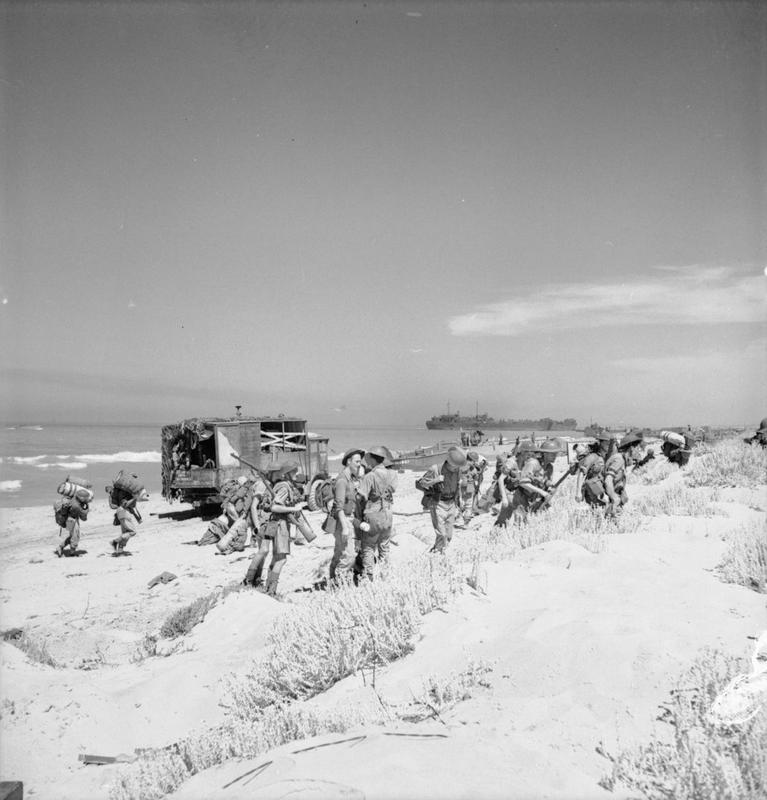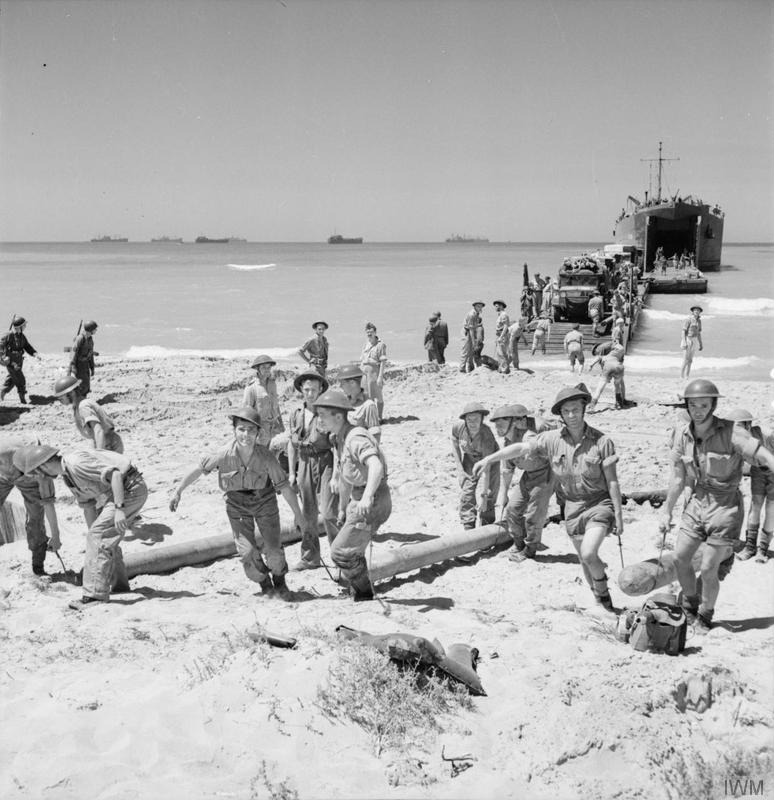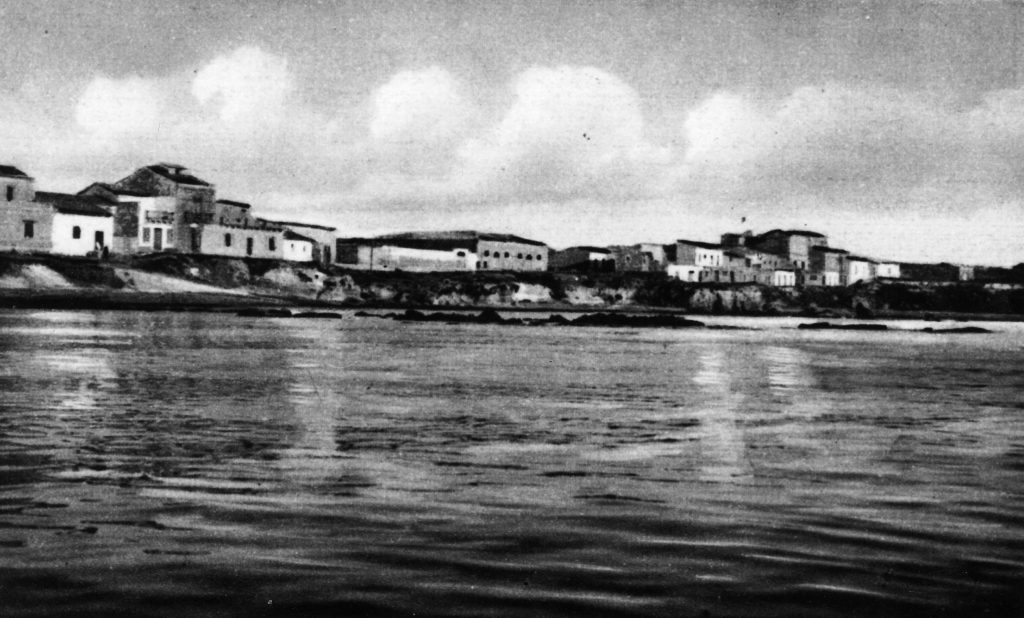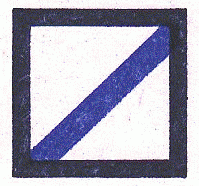Nos. 1 & 2 Auxiliary Embarkation Units
Nos. 1 and 2 R.A.F. Auxiliary Embarkation Units and a Sub-Area Headquarters Unit were formed at Arzew, in Algeria on 1st June 1943.
They were formed to provide an R.A.F. element in a U.S. Army beach organisation for the coming invasion of Sicily and in total, they numbered 5 Officers and 51 Other Ranks. The transport allocated to them totalled 3 jeeps and 5 motor cycles.
Squadron Leader A.D.G. Denvil was Commanding Officer of the Sub-Area Headquarters with a staff of 3 Other Ranks. Each Auxiliary Embarkation Unit (A.E.U.) consisted of 2 Officers and 24 Other Ranks.
Flight Lieutenant A. Wilson was Commanding Officer of No. 1 A.E.U., the other officer being Flight Lieutenant H. Pollard. Flight Lieutenant J. Black was Commanding Officer of No. 2 A.E.U., with Flight Lieutenant N.A. Ovington as the other officer.
The Units were accommodated under canvas in a combined camp on the beach between Arzew and Port Aux Poules, near Oran and began a programme of “Physical Training, including swimming, and Disciplinary Training, including musketry practice”. There was no Combined Operations training because the Army units had not arrived from the U.S.A.
On 27th June, the Units embarked on L.S.T 331 and L.C.I. 237 with the personnel of the three Units being dispersed between the two vessels. L.S.T 331 carried all the transport for the three units and in addition carried 400 tons of aviation and M.T. petrol and oils, ammunition, oxygen, glycol and balloon equipment for R.A.F. use after the landing. The two vessels sailed the next day, in convoy. The sea was calm as they sailed in an easterly direction within sight of the coast of North Africa. The Units did not know their destination. There was an air raid alarm at 11pm on 30th June but the “All Clear” came 20 minutes later and their was no enemy activity.
Early in the morning of 1st July 1943 they arrived in Tunis Bay after an uneventful voyage and with the sea still calm. The vessels tied up alongside the jetty at La Goullette and a working party from the two A.E.U.s was employed on moving cargo to adjust the trim of L.S.T. 331 as specified by the U.S. Naval authorities to meet the condition of the beach on which landing was to be made.
At 9am there was a conference between S/Ldr Denvil, F/Lt Wilson and Lieutenant Mazzotti of the U.S. Coastguard, on board L.S.T. 331 [1]. This was to agree new stowage according to R.A.F. and Naval requirements. There was an air raid alarm at 7.10pm but there was no enemy activity.
On the 4th July, additional personnel and vehicles were embarked on L.S.T. 331 under the direction of F/Lt Wilson who had been appointed Transportation Quartermaster for the ship by the American military authorities in Oran. R.A.F. units embarking included No. 3201 Servicing Commando [2], No. 1 Field Force H.Q. Signals Unit and a balloon unit.
L.C.I. 237 sailed for Sousse on 6th July, arriving the same day. F/Lt Black was the Officer Commanding Troops on board.
On 7th July, Wing Commander R. George, Movements Officer from Headquarters Northwest Africa Tactical Air Force (N.A.T.A.F.) joined L.S.T. 331 and became Officer Commanding Troops.
Operation “HUSKY”
On 8th July L.S.T. 331 and L.C.I. 237 set sail from Tunis and Sousse respectively for Operation “HUSKY”. At sea, at 5pm there was a lecture by W/Cdr George to all the R.A.F. officers on board L.S.T. 331 about the coming Operation. By 8pm, a heavy swell had developed and periodic inspections were made throughout the night to ensure that the vehicles and stowed cargo was secure.
At 7am the next morning, a working party was employed to double-lash the vehicles owing to the increasing storm. This was done efficiently in spite of sea-sickness.
At 4.30, Gozo Island was to starboard of the convoy and more L.S.T.s and L.C.I.s assembled to complete the convoy. The sea was rough and sea-sickness was prevalent among the personnel. At 11.30pm a working party had to secure lashing on the tank deck which had become loose due to the continuing storm.
At dawn on 10th July, Sicily was on the starboard beam. The sea was now calm and enemy air activity was slight.
At 9am L.C.I. 237 beached and the personnel disembarked on “CENT” Beach, two miles west of Scoglitti. The beaching of L.S.T. 331 was delayed due to difficulties in manoeuvring with two pontoons in the heavy swell.
At 11am F/Lt Black visited the Headquarters of 540th Engineers (U.S. Army) to obtain information about arrangements on the beach. No other R.A.F. personnel or equipment was landed owing to the delay in the beaching of L.S.T. 331 and F/Lt Black’s party spent the night on the beach with working parties standing by and sentries posted. There was no shellfire and enemy air activity was slight. The men dug in.
On 11th July, at 8am in the morning, the beach was attacked by two fighter-bombers. There were no R.A.F. casualties and at 10am L.S.T. 331 beached. Vehicles began to run off the ship over the pontoons to the beach. Some vehicles ‘bogged’ in the sand as there was no tracking on the beach. A working party was employed in helping to move the ‘bogged’ vehicles. At midday, the manhandling of stores from ship to beach was started. There was no motor transport available and no labour was available from U.S. Army sources. Dispersed dumps were established on the beach.

[Royal Air Force official photographer, F/Lt B.J.H. Daventry © IWM (CNA 974)]
On disembarkation from L.S.T. 331, No. 3201 R.A.F. Servicing Commando had driven their vehicles straight to Comiso airfield and unloaded them. At 1pm they supplied six 3 ton vehicles to assist in the discharge of stores from L.S.T. 331. They also supplied labour to augment that provided by Nos. 1 & 2 A.E.U.s. There was slight enemy air activity.
Deliveries to Comiso airfield began and the discharge of stores from L.S.T. 331 continued through the rest of the day and through the night. S/Ldr Denvil’s Sub-Area Headquarters had, in the meantime been established in nearby Scoglitti. There was increased enemy air activity at night but no R.A.F. casualties.
On 12th July, unloading continued. The dispersed dumps now extended over 1½ miles of beach. Two additional vehicles were supplied by 540th Engineers to help with moving the stores. There were numerous air raids that night. Some aircraft were shot down by ant-aircraft fire and there were fires on shore and at sea.

[Royal Air Force official photographer, F/Lt B.J.H. Daventry, © IWM (CNA 4180)]
At 2pm on 13th July L.S.T. 331 was fully discharged. The Units began to remove the dumps from the beach to Comiso airfield using 3201 Servicing Commando vehicles and those supplied by 540th Engineers.
Fragmentation bombs were dropped in the vicinity of the beach and the ship but there were no casualties.
At 6pm Nos. 1 & 2 A.E.U.s established a bivouac camp on the beach and working parties were detailed in shifts. Supplies of petrol, oil and ammunition at the airfield were now in satisfactory quantity but further supplies continued to be sent in order to clear the beaches.
On 14th July, a detachment was sent from the beach to Scoglitti for the disembarkation of personnel from L.C.I.s. F/Lt Black was in charge of this detachment, which was increased the next day by two N.C.O.s to man new dumps of stores that were now being landed by DUKWs. The beaches were cleared by 11pm on 15th July.

[from a postcard obtained by Ron Plater when he was there in July 1943]
In the afternoon of 17th July an Air Ammunition Park (A.A.P.) was established at Vittoria to receive supplies of petrol, oils and ammunition being landed. The intention was to build up a reserve away from the vulnerable area of Cosimo airfield. The personnel of Nos. 1 & 2 A.E.U.s at the beach moved camp to the vicinity of the A.A.P.
At around 4pm on 19th July, 1708148, Aircraftman L. Beardsmore was shot by a Sten gun. He was taken to the Casualty Clearing Station in a critical condition. An investigation was held but the circumstances of this incident are not recorded.
Receipts through the beaches were discontinued on 21st July. All imports were now being discharged at Gela under U.S. Army arrangements. All the stocks from the A.A.P. were issued to the airfield at Cosimo. The personnel of Nos. 1 & 2 A.E.U.s were withdrawn from the dumps and beaches to take up duties of liaison between the Cosimo airfield and the American supply organisation at Gela.
On 30th July the Units moved from Vittoria to Gela in motor transport supplied by Headquarters 324 Wing. At Gela, they were to await embarkation for North Africa in accordance with instructions received from Headquarters, Desert Air Force. Two airmen suffering from sandfly fever were left behind in Sick Quarters at Comiso airfield.
At 2pm on 31st July, in accordance with instructions from W/Cdr Jannaway, S.E.S.O., H.Q., N.A.T.A.F., S/Ldr Denvil, F/Lt Black and F/Lt Wilson embarked for North Africa on L.S.T. 331, leaving the rest of the Units attached to No. 3 A.E.U. for embarkation duties. L.S.T. 331 moved to anchor off Gela on a calm sea.
L.S.T. 331 sailed from Gela, Sicily on 2nd August 1943, arriving at Bizerta the next day. It sailed on from there to Tunis on 4th August, arriving at 6pm and docking at La Goulette. The Sub Area Commanding Officer, S/Ldr Denvil, the C.O. of No. 1 A.E.U., F/Lt Wilson and the C.O. of No. 2 A.E.U., F/Lt Black disembarked and went to H.Q., N.A.T.A.F. (Rear) at La Marsa for instructions.
Nos. 1 & 2 A.E.U.s had not received any mail during the whole time they had been in Sicily. Their mail was found at A.P.O. Tunis on 5th August and it was redirected, where necessary, to the personnel at Gela.
Nos. 81 & 82 Auxiliary Embarkation Units
On 5th August 1944 No.1 A.E.U and No. 2 A.E.U. were renamed No. 81 A.E.U. and No. 82 A.E.U. respectively. The Units officers had returned to North Africa in advance of the rest of the Units, which remained in Sicily at Gela.
S/Ldr Denvil, F/Lt Black and F/Lt Wilson left Tunis by road for Tripoli on 10th August. They arrived at Tripoli in the early hours of the 11th August and reported to the Headquarters of the British Army’s No. 21 Beach Group which was under the command of Colonel Watham.
The personnel of Nos. 81 & 82 A.E.U.s returned from Gela by sea and air. Arriving at Tripoli, the Units set up camp with the Army’s No. 4 Ordnance Beach detachment on 14th August and began a disciplinary and physical training programme.
On 20th August, F/Lt Black and F/Lt Wilson attended a conference at Headquarters No. 21 Beach Group to discuss the training programme. S/Ldr Denvil went to Algiers for a briefing.
On 21st August, the R.A.F. personnel took part in a ‘dry’ exercise that was part of the training for the next operation. The results were satisfactory and there was “Excellent co-operation with Army.” A church parade the next day was attended by all ranks and then Unit vehicles were camouflaged according to the scheme required for the next operation.
There was a conference at Headquarters, No. 21 Beach Group in the morning of 23rd August to discuss the ‘dry’ exercise held two days previously. F/Lt Wilson attended. In the afternoon, F/Lt Wilson gave a lecture to the airmen of Nos. 81 & 82 A.E.U.s to instruct them on important points brought up at that morning’s conference.
“Disciplinary and physical training, and daily lecture continued. Airmen in high state of physical fitness.”
On 24th August, Unit vehicles were despatched to the docks for waterproofing and embarkation, mosquito nets were dyed with potassium permanganate for camouflage, there was firing practise for all ranks with rifle, Sten gun and revolver (“Average good”) and there were organised games – “Football against No. 4 O.B.D. (Lost. 2-1)”. S/Ldr Denvil returned from Algiers.
Group Captain Tyler arrived from Headquarters, Mediterranean Air Command on 26th August. On his authority, S/Ldr Denvil was posted to command Nos. 68 and 69 R.A.F. Beach Units and F/Lt Black was promoted to Acting Squadron Leader to command Nos. 81 and 82 A.E.U.s.
On 31st August 1943, S/Ldr Black and F/Lt Wilson attended a conference at Headquarters, No 169 Brigade, Tripoli to hear details of Operation “AVALANCHE”.
Operation “AVALANCHE”
On 1st September 1943, Nos. 81 & 82 A.E.U.s moved to the embarkation assembly area on Tripoli Racecourse. They embarked on L.S.T. 365 on the morning of 2nd September. Their vehicles had already been embarked by the R.E.M.E. waterproofing organisation.
There were a few days on board before sailing. On 5th September there were organised games – swimming and boxing. The Units were well represented in boxing and won a number of fights. At 11pm that night, L.S.T. 365 sailed. The sea was calm.
While at sea, on 8th September, the B.B.C. announced the surrender of Italy but the Units were warned not to expect a ‘walk-over’ landing. As if to emphasise that point, there was a heavy air attack on the convoy at 8pm that evening but there were no casualties.
At dawn on D-Day, 9th September 1943, L.S.T. 365 arrived in the Bay of Salerno, off “SUGAR” Beach. The sea was calm, there was slight enemy air activity and enemy shells landed in the vicinity of the ship but exploded harmlessly under water.
At 9am, S/Ldr Black and F/Lt Wilson went ashore in a DUKW. The beach was under shellfire. Colonel Watham, Officer Commanding No. 21 Beach Group, did not expect the airfield at Montecorvino to be captured early because there was stiff enemy resistance. It was not yet possible to set up dumps owing to shellfire and the limited area that was in Allied hands at that time.

[Picture by Sgt. Gee, No. 2 Army Film & Photographic Unit, © IWM (NA 6636)]
Nos. 81 & 82 A.E.U.s disembarked on SUGAR Beach at 11am and moved into the cover provided by a tomato plantation in the Beach Group assembly area. The roads were under shellfire but the Units arrived without casualty, although some airmen’s kit was damaged by shellfire. The men remained in cover owing to sniping.
The sniping ceased at around 1pm. S/Ldr Black moved to Headquarters No. 56 Division and F/Lt Wilson to Headquarters, No. 21 Beach Group, which were in adjacent fields. At 6pm there was an air raid with bombs landing on the beach. There were no casualties. No stores were landed on the first day.
On D+1, the distribution of the combined Units was as follows:
- S/Ldr Black at Divisional H.Q. with one Clerk, one Driver and one Despatch Rider.
- F/Lt Wilson at Beach Group H.Q. with two Aircrafthands employed as Runners.
- F/Lt Pollard at the Personnel Assembly Area with one F/Sgt, one Cpl. and three Airmen.
- F/Lt Ovington based at the bivouac area with relief parties.
- One N.C.O. and three Airmen at the Ammunition Dump.
- One N.C.O. and three Airmen at the Petrol Dump.
- One N.C.O. and six Airmen on shifts on the beach.
R.A.F. equipment was landed in small quantities. Temporary landing grounds were being constructed in the Beach Area owing to the anticipated delay in Montecorvino airfield becoming secure enough for operations. The limited supplies landed were to be held in dumps until required. Enemy action was on a reduced scale. At night, there were air raids, but no casualties in the Unit.
On 11th September (D+2) movement of supplies to Montecorvino airfield was commenced. On 12th September (D+3) these supplies were discontinued and supplies were instead commenced to the temporary landing ground in the ROGER beach area. Aircraft were now using the ROGER landing ground, “Tusciano”, and the quantity of supplies landed over the beaches was now sufficient for immediate needs. Supplies were commenced to “Asa” landing ground. (The newly constructed landing grounds were named after the rivers near which they were located.)
At 8pm on 13th September there was an air raid alarm. Bombs were dropped on the petrol dump and fires were started. The officer in charge of the petrol dump declined offers of assistance, his own staff being sufficient to deal with it. There were no casualties among R.A.F. personnel and no aircraft fuel or oil was lost in the fire.
Instructions were issued on 14th September that for the immediate future, all R.A.F. and U.S.A.A.F. personnel would be landed on ROGER Beach where Nos. 68 & 69 R.A.F. Beach Units were operating, and all stores would be landed on SUGAR Beach, where Nos. 81 & 82 A.E.U.s were operating.
At midday on 16th September the ammunition dump was shelled with fragmentation projectiles. Again, there were no R.A.F. casualties. However, at 11pm, the beach was bombed again. Some Unit personnel received superficial wounds but they were all able to remain on duty.
In an air raid at 5am on 17th September, Aircraftman Yendell was wounded and he was evacuated to hospital. At 11am, roads were under shellfire but there were no casualties. Finally, at 11pm, bombs were dropped on the ammunition dump but there were no casualties and no damage.
On 18th September enemy action in the SUGAR beach area was negligible. In the morning S/Ldr Black established his Sub-Area Headquarters at Pontecagnano. An Air Forces Transit Area was established in the SUGAR beach area.
On 19th September instructions were issued that the petrol dump in the SUGAR Beach Area was to be the main depot and a 68/69 Beach Unit party from the ROGER petrol dump came over to the SUGAR dump. The petrol depot that had been staffed by Nos. 68 & 69 Beach Units was taken over by a party from Nos. 81 & 82 A.E.U.s on 21st September.
On 23rd September it was decided that Nos. 81 & 82 A.E.U.s would now, additionally control ROGER Beach, with the assistance of Nos. 68 & 69 Beach Units. This was to enable Nos. 68 & 69 Beach Units, who were being held ready to move, to leave quickly when the order came. F/Lt Ovington and a party of six from Nos. 81 & 82 A.E.U.s went to ROGER Beach to take over.
During the latter part of September 1944, Nos. 81 & 82 A.E.U.s were employed almost entirely on disembarkation of personnel and routing of units in transit, with small detachments employed in ammunition and petrol dumps. Collection from dumps to supply the Montecorvino, Tusciano and Asa airfields was carried out by airfield personnel under their own arrangements.
On 12th October S/L Black went with the Commanding Officers of No. 35 Beach Brick, R.A.F. Component and Nos. 68 & 69 R.A.F. Beach Units to visit No. 67 Embarkation Unit at Taranto to investigate the possibility of setting up a transit camp at Taranto. Next day, there was a visit to the Embarkation Unit at Bari to discuss the transit camp question and W/Cdr George discussed with the officers information received from Group Captain Bates about the future of Beach Units. W/Cdr George was working to determine the future of all officers and men currently serving in the various beach units, according to the wants of the men and the needs of the R.A.F.
S/Ldr Black travelled back on 14th October. Nos. 81 & 82 A.E.U.s had broken camp to go to Bari but were recalled. As a result of this they urgently needed somewhere to camp and on 15th October, they were accommodated with difficulty, in the farm grounds occupied by Nos. 68 & 69 R.A.F. Beach Units.
On 16th October S/Ldr Black went to search for better accommodation in the Naples area with F/Lt Kinney from Nos. 68 & 69 R.A.F. Beach Units. Next day, S/Ldr Cooke arrived from T.A.F. to obtain more information about officers and men so that the establishment of the new R.A.F. Beach Group could be completed. He went on to Naples to contact S/Ldr Black and other officers.
Nos. 81 & 82 R.A.F. Auxiliary Embarkation Units were disbanded at the end of October 1943. F/Lt H. Pollard and F/Lt N.A. Ovington joined the new R.A.F. Beach Group (later renamed No. 5 R.A.F. Beach Unit). F/Lt A. Wilson went with the beach unit personnel returning to the U.K., where he joined No. 4 R.A.F. Beach Unit.
[1] There is an interesting account of what happened to LST 331 in this operation, written by the ship’s Executive Officer, Lieutenant W. D. Strauch, Jr., USCG. This can be read at www.ibiblio.org/hyperwar/USCG/X-Sicily-Italy/USCG-X-1.html
[2] A parallel account of the voyage, landing and unloading of LST 331 and LCI 237 from the point of view of No. 3201 S.C.U. gives added insight to these events and can be read in the book, “A History of the RAF Servicing Commandos” by J P Kellett & J Davies, Airlife, 1989.
Main source used for this page:
Operations Record Book of Nos. 81 & 82 Auxiliary Embarkation Units (Formerly Nos. 1 & 2 Auxiliary Embarkation Units) – found in, ‘Air Ministry and Ministry of Defence: Operations Record Books, Miscellaneous Units’ AIR 29/438 at The National Archives.
All quotes, unless otherwise indicated, are from this source.
